‘69’s Rheingau Mini-Reunion, September, 2013
Reflections and Notes by Randy Hack, David Fisher and Lindsay and Eric Johnson
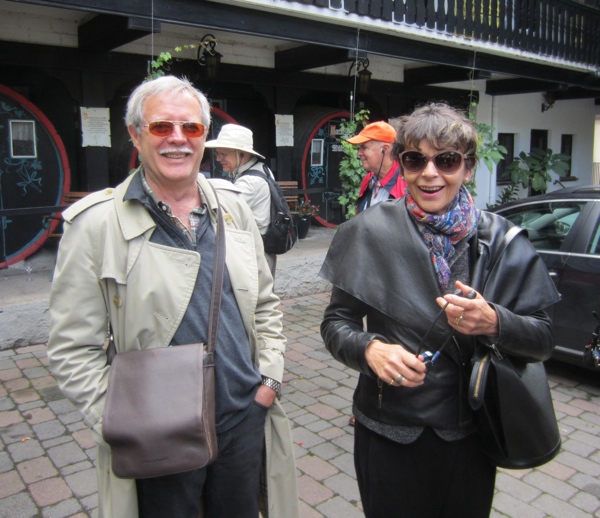 Few,
if any, of the classmates and spouses who gathered for our mini-reunion in Wiesbaden,
Germany on September 16th could have told you what the Rheingau is,
or found it on a map, or explained its significance for the German people. But now we know, thanks to our hosts – classmate
David Fisher and his German wife Étel, a marvelously energetic and gracious
couple – who crafted this mini reunion, and together with Michael Jennings (PU
Professor of German Studies and unabashed oenologist), led us on this
mini-reunion adventure.
Few,
if any, of the classmates and spouses who gathered for our mini-reunion in Wiesbaden,
Germany on September 16th could have told you what the Rheingau is,
or found it on a map, or explained its significance for the German people. But now we know, thanks to our hosts – classmate
David Fisher and his German wife Étel, a marvelously energetic and gracious
couple – who crafted this mini reunion, and together with Michael Jennings (PU
Professor of German Studies and unabashed oenologist), led us on this
mini-reunion adventure.
So,
what is the Rheingau? It’s simple,
and yet it’s not. For Germans the
Rheingau has multiple dimensions – geophysical, economic, historical,
political, cultural and at bottom even spiritual in the same sense that, for
Americans, the Mississippi is far more than just a river, and it occupies much
of the cultural imagination of Germans as evidenced in Heinrich Heine’s poetry.
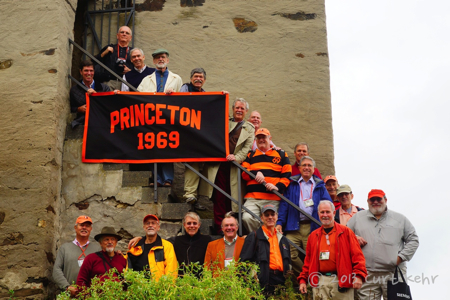 Geographically, the Rheingau is a beautiful stretch
of the Rhine River valley in central/west Germany running from Wiesbaden north
to Koblenz. It has been populated
since the most recent Ice Age, and served as a spa (Wies(e) Baden = "meadow
baths”) for visiting soldiers during the Roman Empire until the late fourth
century; and Wiesbaden would become a meeting place for high society again in
the 19th century.
Geographically, the Rheingau is a beautiful stretch
of the Rhine River valley in central/west Germany running from Wiesbaden north
to Koblenz. It has been populated
since the most recent Ice Age, and served as a spa (Wies(e) Baden = "meadow
baths”) for visiting soldiers during the Roman Empire until the late fourth
century; and Wiesbaden would become a meeting place for high society again in
the 19th century. 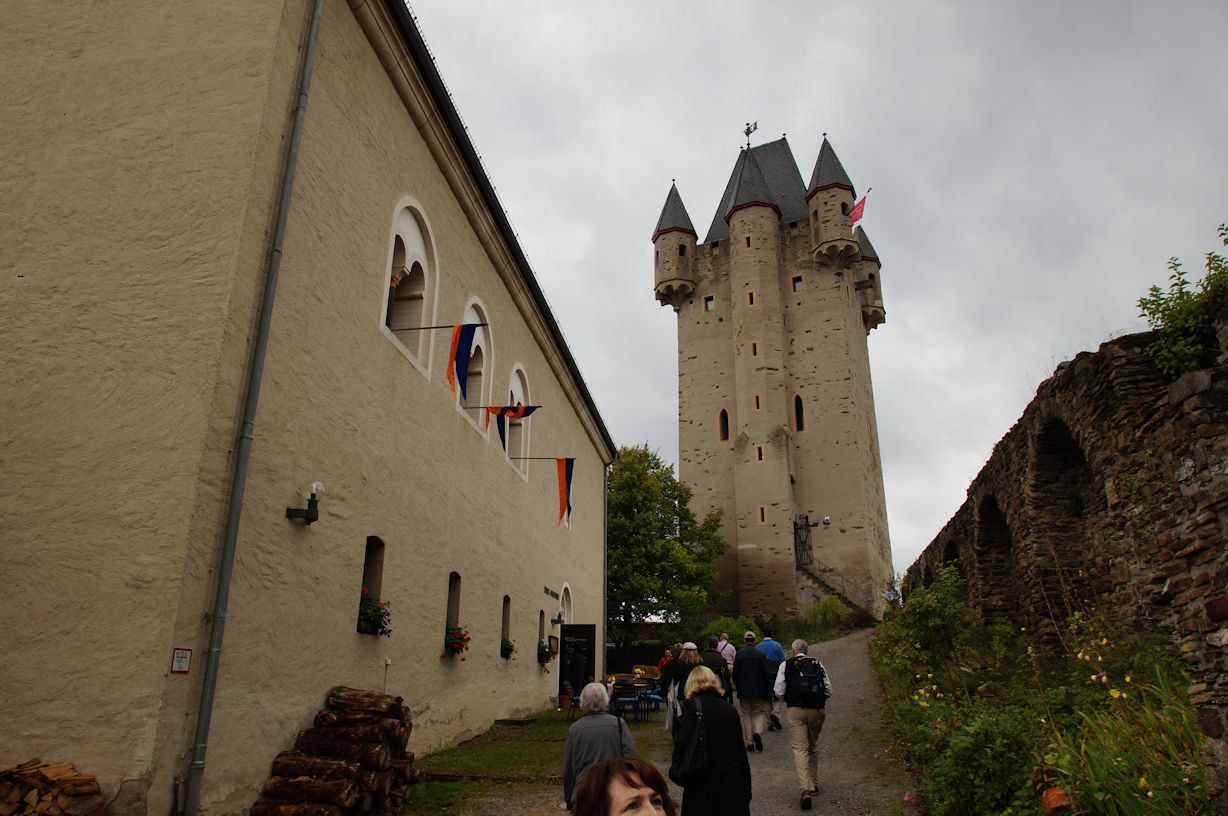 There
are castles on high promontories looming around every bend, quaint villages
edging the river banks, overflowing barges running in both directions to feed
German commerce, vineyards blanketing the steep slopes above the Rhine, and wineries
at every turn producing the finest Rieslings in the world. All that, plus Romanesque cathedrals, a
Benedictine monastery, gambling casinos, brilliantly selected regional cuisines
and best of all, a visit to the castle which had been in the Nassau line of
dukes, princes, counts and other rapscallions for almost a millennium.
There
are castles on high promontories looming around every bend, quaint villages
edging the river banks, overflowing barges running in both directions to feed
German commerce, vineyards blanketing the steep slopes above the Rhine, and wineries
at every turn producing the finest Rieslings in the world. All that, plus Romanesque cathedrals, a
Benedictine monastery, gambling casinos, brilliantly selected regional cuisines
and best of all, a visit to the castle which had been in the Nassau line of
dukes, princes, counts and other rapscallions for almost a millennium.
 After a weekend in Berlin the group traveled to Wiesbaden
where we gathered for dinner our first evening at the Villa Clementine, once
the home of a prominent literary society, and were treated to a lecture by the
class's own Wagner expert, Sheldon Reaven, including four minutes of
sustained E Flat Major, Wagner’s musical attempt to emulate the undulating
rhythms of the ever flowing Rhine.
Wiesbaden was the waypoint in a 28-year break in Wagner’s completion of
the four-part Ring cycle, the composer’s famous rendition of various Norse
legends, particularly the Song of the Nibelungen from the 12th and
13th centuries that limned, in much the way the Iliad had for Greeks
and Trojans, the existential life and downfall of the Burgundians. Sheldon’s knowledge of German history,
and his passion for Wagner, became one of the recurring themes of our trip as
he regularly noted Wagner’s connections to many of the places we visited. Finding Wagner in the Rheingau quickly
became akin to Finding Waldo.
After a weekend in Berlin the group traveled to Wiesbaden
where we gathered for dinner our first evening at the Villa Clementine, once
the home of a prominent literary society, and were treated to a lecture by the
class's own Wagner expert, Sheldon Reaven, including four minutes of
sustained E Flat Major, Wagner’s musical attempt to emulate the undulating
rhythms of the ever flowing Rhine.
Wiesbaden was the waypoint in a 28-year break in Wagner’s completion of
the four-part Ring cycle, the composer’s famous rendition of various Norse
legends, particularly the Song of the Nibelungen from the 12th and
13th centuries that limned, in much the way the Iliad had for Greeks
and Trojans, the existential life and downfall of the Burgundians. Sheldon’s knowledge of German history,
and his passion for Wagner, became one of the recurring themes of our trip as
he regularly noted Wagner’s connections to many of the places we visited. Finding Wagner in the Rheingau quickly
became akin to Finding Waldo.
Then followed tours of Wiesbaden and Mainz
(sister cities directly across the Rhine from each other, and between whom no
love is lost), Worms and Speyer. Wiesbaden, as the capital of the ancient
Land of Nassau, provided the theme that united many of the venues: the
investigation of the connection between Princeton and the House of Nassau. 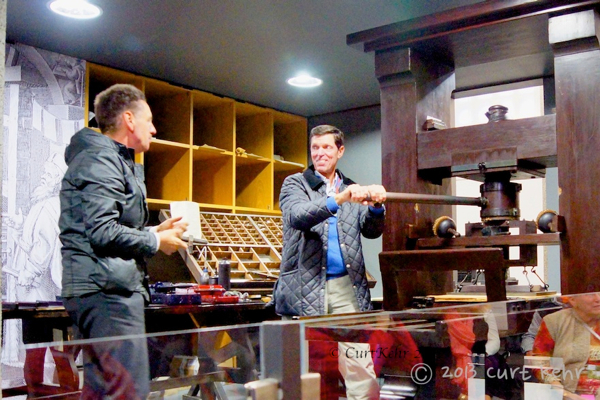 The
group walked past Wiesbaden’s Nassau Cathedral and took a fascinating tour of
the Gutenberg Museum in Mainz where classmate Thacher Brown was recruited to
man the replica Gutenberg press and, with great exertion, managed to produce a
single page of the Bible in about the time it would take today to print out his
entire senior thesis. Gutenberg
did not so much invent a printing press as he modified extant wine presses,
which were plentiful in the Rheingau. The abundance of wine production in the
area was prompted in part from the lack of healthful water. A more sobering
reminder of German history lay in the modern Mainz synagogue that came to
replace the traditional one destroyed during Kristallnacht.
The
group walked past Wiesbaden’s Nassau Cathedral and took a fascinating tour of
the Gutenberg Museum in Mainz where classmate Thacher Brown was recruited to
man the replica Gutenberg press and, with great exertion, managed to produce a
single page of the Bible in about the time it would take today to print out his
entire senior thesis. Gutenberg
did not so much invent a printing press as he modified extant wine presses,
which were plentiful in the Rheingau. The abundance of wine production in the
area was prompted in part from the lack of healthful water. A more sobering
reminder of German history lay in the modern Mainz synagogue that came to
replace the traditional one destroyed during Kristallnacht.
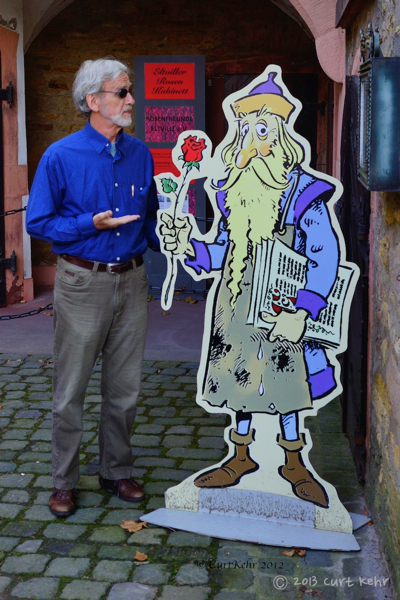 In
mid-week, we slipped down the Rhine for hours on our own private riverboat to
Koblenz, viewing the monasteries that produced the wines for which the region
is famed, with a memorable stop at Rüdesheim, a perfect example of the German
village of your imagination. Rüdesheim
is a blend of crooked narrow streets, half-timbered buildings of quaint authenticity,
and the usual tourist kitsch. We made
a brief stop at a sidewalk café to enjoy that famous Rüdesheim special, coffee
"mit” flaming brandy, then rode a mini-gondola lazily up and over the vineyards
to the Niederwald Monument in bronze bas relief that memorializes the
foundation of the German Empire in 1870.
In
mid-week, we slipped down the Rhine for hours on our own private riverboat to
Koblenz, viewing the monasteries that produced the wines for which the region
is famed, with a memorable stop at Rüdesheim, a perfect example of the German
village of your imagination. Rüdesheim
is a blend of crooked narrow streets, half-timbered buildings of quaint authenticity,
and the usual tourist kitsch. We made
a brief stop at a sidewalk café to enjoy that famous Rüdesheim special, coffee
"mit” flaming brandy, then rode a mini-gondola lazily up and over the vineyards
to the Niederwald Monument in bronze bas relief that memorializes the
foundation of the German Empire in 1870.
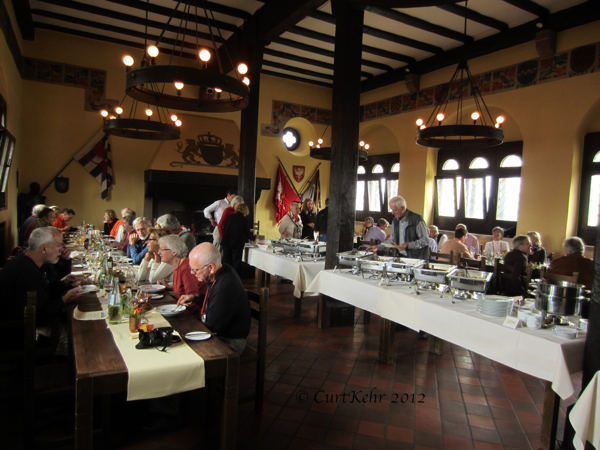 After a steep walk from the village of Nassau up to
the original castle of the House of Nassau, we lunched in the Hall of Knights,
not unlike a mini-Commons, where we were welcomed by the Mayor of Nassau. At meal’s end the
group serenaded him with "Old Nassau.” The mayor
was so pleased that he agreed to take a Princeton intern next summer.
After a steep walk from the village of Nassau up to
the original castle of the House of Nassau, we lunched in the Hall of Knights,
not unlike a mini-Commons, where we were welcomed by the Mayor of Nassau. At meal’s end the
group serenaded him with "Old Nassau.” The mayor
was so pleased that he agreed to take a Princeton intern next summer.
Before
leaving we spent time with a local historian who shared his experience living
through WWII at age five. One
night near the end of the war the townspeople hid in old industrial mines as
British bombers passed over on their way home from a raid on interior
Germany. Our historian opined that
the British had no official targets left to bomb, and thus let loose their
remaining munitions on Nassau, a small village of no strategic importance, and
largely destroyed it.
 Then
on to a night in Bad Ems, yet another spa and casino town in the Rheingau, at
Häckers Hotel, replete with the usual thermal pool and multiple saunas where
several shocked spouses came to understand belatedly that there is no word for
"modesty” in the German vocabulary.
Like
Wiesbaden, Bad Ems was a vacation spot for the rich and famous whose mingling
as they took the waters produced its share of historical encounters, including
what became the triggering event of the Franco-Prussian War.
Then
on to a night in Bad Ems, yet another spa and casino town in the Rheingau, at
Häckers Hotel, replete with the usual thermal pool and multiple saunas where
several shocked spouses came to understand belatedly that there is no word for
"modesty” in the German vocabulary.
Like
Wiesbaden, Bad Ems was a vacation spot for the rich and famous whose mingling
as they took the waters produced its share of historical encounters, including
what became the triggering event of the Franco-Prussian War.
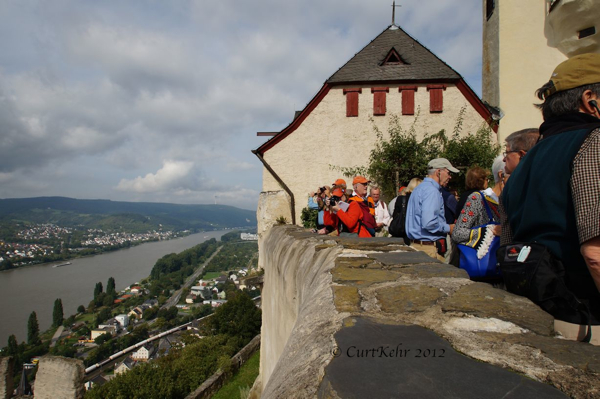 We
explored Marksburg, the only fully intact castle remaining in the Rheingau,
room by room. Of special note, the
torture room, replete with such interesting devices as the iron "Pig’s Head”, a
heavy, grated head covering topped by a piggish nose, meant to inflict deep
humiliation and neck strain on the wearer. Several class wags briefly considered pilfering the device,
reasoning that it would be apt punishment for the last dilatory classmate to
board our bus each morning.
We
explored Marksburg, the only fully intact castle remaining in the Rheingau,
room by room. Of special note, the
torture room, replete with such interesting devices as the iron "Pig’s Head”, a
heavy, grated head covering topped by a piggish nose, meant to inflict deep
humiliation and neck strain on the wearer. Several class wags briefly considered pilfering the device,
reasoning that it would be apt punishment for the last dilatory classmate to
board our bus each morning.
 We
returned to the Rhine again on yet another riverboat to enjoy the Night of
We
returned to the Rhine again on yet another riverboat to enjoy the Night of 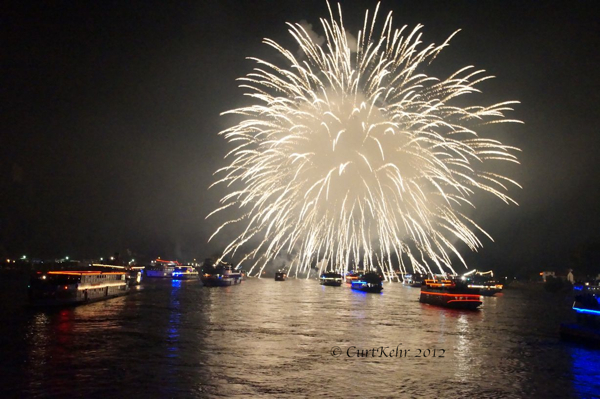 the
Lorelei, this time accompanied by two hundred of our closest German friends – dinner
first, and then the "Rhein in
Flammen,” a spectacular display of "revolving” fireworks, sometimes pouring
like molten gold from a castle on the left bank, then launching themselves from
a high castle promontory on the right bank, and, most dramatic of all, rockets
catapulted from a boat just ahead of us in the river and showering us directly overhead with
brilliant blazing shapes and sounds.
the
Lorelei, this time accompanied by two hundred of our closest German friends – dinner
first, and then the "Rhein in
Flammen,” a spectacular display of "revolving” fireworks, sometimes pouring
like molten gold from a castle on the left bank, then launching themselves from
a high castle promontory on the right bank, and, most dramatic of all, rockets
catapulted from a boat just ahead of us in the river and showering us directly overhead with
brilliant blazing shapes and sounds.
The trip segment in the Rheingau
culminated the next day in a visit to Eltville, a walking wine-tasting tour of
Eberbach Monastery, formed by the Benedictines, where we had the rare
opportunity to see the Codex of Saint Hildegard, an astoundingly modern and
multi-talented woman, and then went on to enjoy not one but six (!!!) wines as
we were fed snippets of monkish history and guided to different tasting
stations in the monastery. By the
time we reached tasting station three, most of us could not have spelled
"Benedictine” and were surreptitiously fertilizing the courtyard shrubs with fine
Reisling.
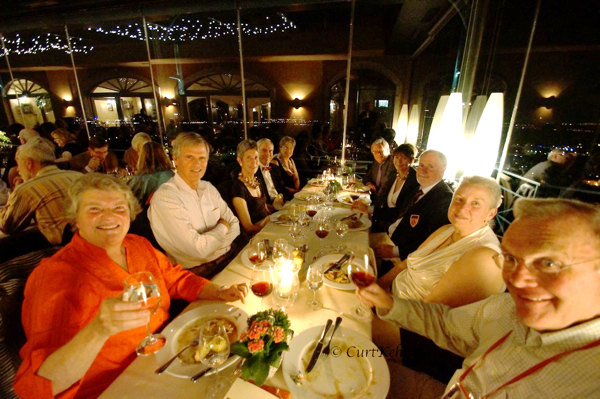 Part of the group continued on to Munich to
experience Oktoberfest but for many the trip ended with our farewell dinner at
Schloss Johannisberg. As Randy Hack
noted, it was "an exquisite meal seasoned with great camaraderie and deep
expressions of gratitude to David and Étel, Bill and Anne Charrier, and the many
others who labored to make this trip a great success. As we looked down from heights of Schloss Johannisberg, the lights
along the Rhine were twinkling in the distance. The Rhine, always the Rhine, the river that had carved this
valley over millennia and woven its way inextricably through everything we had
come to experience on this journey together. As we stood there enjoying this final vista, some of us
reflected, as many have on prior class trips, that one of most powerful aspects
of these mini-reunions is the opportunity to renew bonds with old friends, and
to form new bonds with classmates one might have known only in passing during
our time at Princeton. These mini-reunions
continue to demonstrate that they are a wonderful way to gather, learn and
laugh.
Part of the group continued on to Munich to
experience Oktoberfest but for many the trip ended with our farewell dinner at
Schloss Johannisberg. As Randy Hack
noted, it was "an exquisite meal seasoned with great camaraderie and deep
expressions of gratitude to David and Étel, Bill and Anne Charrier, and the many
others who labored to make this trip a great success. As we looked down from heights of Schloss Johannisberg, the lights
along the Rhine were twinkling in the distance. The Rhine, always the Rhine, the river that had carved this
valley over millennia and woven its way inextricably through everything we had
come to experience on this journey together. As we stood there enjoying this final vista, some of us
reflected, as many have on prior class trips, that one of most powerful aspects
of these mini-reunions is the opportunity to renew bonds with old friends, and
to form new bonds with classmates one might have known only in passing during
our time at Princeton. These mini-reunions
continue to demonstrate that they are a wonderful way to gather, learn and
laugh.
All in all, a magnificent time. Click here to view the photo albums of the trip.



 Few,
if any, of the classmates and spouses who gathered for our mini-reunion in Wiesbaden,
Germany on September 16th could have told you what the Rheingau is,
or found it on a map, or explained its significance for the German people. But now we know, thanks to our hosts – classmate
David Fisher and his German wife Étel, a marvelously energetic and gracious
couple – who crafted this mini reunion, and together with Michael Jennings (PU
Professor of German Studies and unabashed oenologist), led us on this
mini-reunion adventure.
Few,
if any, of the classmates and spouses who gathered for our mini-reunion in Wiesbaden,
Germany on September 16th could have told you what the Rheingau is,
or found it on a map, or explained its significance for the German people. But now we know, thanks to our hosts – classmate
David Fisher and his German wife Étel, a marvelously energetic and gracious
couple – who crafted this mini reunion, and together with Michael Jennings (PU
Professor of German Studies and unabashed oenologist), led us on this
mini-reunion adventure. Geographically, the Rheingau is a beautiful stretch
of the Rhine River valley in central/west Germany running from Wiesbaden north
to Koblenz. It has been populated
since the most recent Ice Age, and served as a spa (Wies(e) Baden = "meadow
baths”) for visiting soldiers during the Roman Empire until the late fourth
century; and Wiesbaden would become a meeting place for high society again in
the 19th century.
Geographically, the Rheingau is a beautiful stretch
of the Rhine River valley in central/west Germany running from Wiesbaden north
to Koblenz. It has been populated
since the most recent Ice Age, and served as a spa (Wies(e) Baden = "meadow
baths”) for visiting soldiers during the Roman Empire until the late fourth
century; and Wiesbaden would become a meeting place for high society again in
the 19th century.  There
are castles on high promontories looming around every bend, quaint villages
edging the river banks, overflowing barges running in both directions to feed
German commerce, vineyards blanketing the steep slopes above the Rhine, and wineries
at every turn producing the finest Rieslings in the world. All that, plus Romanesque cathedrals, a
Benedictine monastery, gambling casinos, brilliantly selected regional cuisines
and best of all, a visit to the castle which had been in the Nassau line of
dukes, princes, counts and other rapscallions for almost a millennium.
There
are castles on high promontories looming around every bend, quaint villages
edging the river banks, overflowing barges running in both directions to feed
German commerce, vineyards blanketing the steep slopes above the Rhine, and wineries
at every turn producing the finest Rieslings in the world. All that, plus Romanesque cathedrals, a
Benedictine monastery, gambling casinos, brilliantly selected regional cuisines
and best of all, a visit to the castle which had been in the Nassau line of
dukes, princes, counts and other rapscallions for almost a millennium. After a weekend in Berlin the group traveled to Wiesbaden
where we gathered for dinner our first evening at the Villa Clementine, once
the home of a prominent literary society, and were treated to a lecture by the
class's own Wagner expert, Sheldon Reaven, including four minutes of
sustained E Flat Major, Wagner’s musical attempt to emulate the undulating
rhythms of the ever flowing Rhine.
Wiesbaden was the waypoint in a 28-year break in Wagner’s completion of
the four-part Ring cycle, the composer’s famous rendition of various Norse
legends, particularly the Song of the Nibelungen from the 12th and
13th centuries that limned, in much the way the Iliad had for Greeks
and Trojans, the existential life and downfall of the Burgundians. Sheldon’s knowledge of German history,
and his passion for Wagner, became one of the recurring themes of our trip as
he regularly noted Wagner’s connections to many of the places we visited. Finding Wagner in the Rheingau quickly
became akin to Finding Waldo.
After a weekend in Berlin the group traveled to Wiesbaden
where we gathered for dinner our first evening at the Villa Clementine, once
the home of a prominent literary society, and were treated to a lecture by the
class's own Wagner expert, Sheldon Reaven, including four minutes of
sustained E Flat Major, Wagner’s musical attempt to emulate the undulating
rhythms of the ever flowing Rhine.
Wiesbaden was the waypoint in a 28-year break in Wagner’s completion of
the four-part Ring cycle, the composer’s famous rendition of various Norse
legends, particularly the Song of the Nibelungen from the 12th and
13th centuries that limned, in much the way the Iliad had for Greeks
and Trojans, the existential life and downfall of the Burgundians. Sheldon’s knowledge of German history,
and his passion for Wagner, became one of the recurring themes of our trip as
he regularly noted Wagner’s connections to many of the places we visited. Finding Wagner in the Rheingau quickly
became akin to Finding Waldo. The
group walked past Wiesbaden’s Nassau Cathedral and took a fascinating tour of
the Gutenberg Museum in Mainz where classmate Thacher Brown was recruited to
man the replica Gutenberg press and, with great exertion, managed to produce a
single page of the Bible in about the time it would take today to print out his
entire senior thesis
The
group walked past Wiesbaden’s Nassau Cathedral and took a fascinating tour of
the Gutenberg Museum in Mainz where classmate Thacher Brown was recruited to
man the replica Gutenberg press and, with great exertion, managed to produce a
single page of the Bible in about the time it would take today to print out his
entire senior thesis In
mid-week, we slipped down the Rhine for hours on our own private riverboat to
Koblenz, viewing the monasteries that produced the wines for which the region
is famed, with a memorable stop at Rüdesheim, a perfect example of the German
village of your imagination. Rüdesheim
is a blend of crooked narrow streets, half-timbered buildings of quaint authenticity,
and the usual tourist kitsch. We made
a brief stop at a sidewalk café to enjoy that famous Rüdesheim special, coffee
"mit” flaming brandy, then rode a mini-gondola lazily up and over the vineyards
to the Niederwald Monument in bronze bas relief that memorializes the
foundation of the German Empire in 1870.
In
mid-week, we slipped down the Rhine for hours on our own private riverboat to
Koblenz, viewing the monasteries that produced the wines for which the region
is famed, with a memorable stop at Rüdesheim, a perfect example of the German
village of your imagination. Rüdesheim
is a blend of crooked narrow streets, half-timbered buildings of quaint authenticity,
and the usual tourist kitsch. We made
a brief stop at a sidewalk café to enjoy that famous Rüdesheim special, coffee
"mit” flaming brandy, then rode a mini-gondola lazily up and over the vineyards
to the Niederwald Monument in bronze bas relief that memorializes the
foundation of the German Empire in 1870.  After a steep walk from the village of Nassau up to
the original castle of the House of Nassau, we lunched in the Hall of Knights,
not unlike a mini-Commons, where we were welcomed by the Mayor of Nassau. At meal’s end the
group serenaded him with "Old Nassau.” The mayor
was so pleased that he agreed to take a Princeton intern next summer.
After a steep walk from the village of Nassau up to
the original castle of the House of Nassau, we lunched in the Hall of Knights,
not unlike a mini-Commons, where we were welcomed by the Mayor of Nassau. At meal’s end the
group serenaded him with "Old Nassau.” The mayor
was so pleased that he agreed to take a Princeton intern next summer. Then
on to a night in Bad Ems, yet another spa and casino town in the Rheingau, at
Häckers Hotel, replete with the usual thermal pool and multiple saunas where
several shocked spouses came to understand belatedly that there is no word for
"modesty” in the German vocabulary.
Like
Wiesbaden, Bad Ems was a vacation spot for the rich and famous whose mingling
as they took the waters produced its share of historical encounters, including
what became the triggering event of the Franco-Prussian War.
Then
on to a night in Bad Ems, yet another spa and casino town in the Rheingau, at
Häckers Hotel, replete with the usual thermal pool and multiple saunas where
several shocked spouses came to understand belatedly that there is no word for
"modesty” in the German vocabulary.
Like
Wiesbaden, Bad Ems was a vacation spot for the rich and famous whose mingling
as they took the waters produced its share of historical encounters, including
what became the triggering event of the Franco-Prussian War. We
explored Marksburg, the only fully intact castle remaining in the Rheingau,
room by room. Of special note, the
torture room, replete with such interesting devices as the iron "Pig’s Head”, a
heavy, grated head covering topped by a piggish nose, meant to inflict deep
humiliation and neck strain on the wearer. Several class wags briefly considered pilfering the device,
reasoning that it would be apt punishment for the last dilatory classmate to
board our bus each morning.
We
explored Marksburg, the only fully intact castle remaining in the Rheingau,
room by room. Of special note, the
torture room, replete with such interesting devices as the iron "Pig’s Head”, a
heavy, grated head covering topped by a piggish nose, meant to inflict deep
humiliation and neck strain on the wearer. Several class wags briefly considered pilfering the device,
reasoning that it would be apt punishment for the last dilatory classmate to
board our bus each morning. We
returned to the Rhine again on yet another riverboat to enjoy the Night of
We
returned to the Rhine again on yet another riverboat to enjoy the Night of  the
Lorelei, this time accompanied by two hundred of our closest German friends – dinner
first, and then the "Rhein in
Flammen,” a spectacular display of "revolving” fireworks, sometimes pouring
like molten gold from a castle on the left bank, then launching themselves from
a high castle promontory on the right bank, and, most dramatic of all, rockets
catapulted from a boat just ahead of us in the river and showering us directly overhead with
brilliant blazing shapes and sounds.
the
Lorelei, this time accompanied by two hundred of our closest German friends – dinner
first, and then the "Rhein in
Flammen,” a spectacular display of "revolving” fireworks, sometimes pouring
like molten gold from a castle on the left bank, then launching themselves from
a high castle promontory on the right bank, and, most dramatic of all, rockets
catapulted from a boat just ahead of us in the river and showering us directly overhead with
brilliant blazing shapes and sounds.  Part of the group continued on to Munich to
experience Oktoberfest but for many the trip ended with our farewell dinner at
Schloss Johannisberg.
Part of the group continued on to Munich to
experience Oktoberfest but for many the trip ended with our farewell dinner at
Schloss Johannisberg.